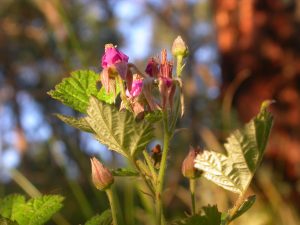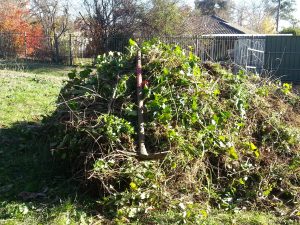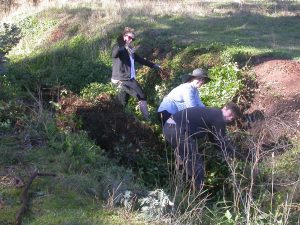
Native Raspberry, Rubus parvifolia (W.Pix 2020) one of the native species volunteers have planted along the drainage line after removing environmental weeds.
Come along and give a hand at the Friends of Mt Majura working party on Sunday, 24 April; help remove weeds and plant local native ground-dwelling plants along the drainage ditch close to the Hackett water tank.
When: Sunday 24 April 2022, 1-4 pm; give as much time as you like.
Where: Meet at the drainage line close to the water reservoir off Rivett Street and French Street intersection, Hackett; view this map.
What: Removing weeds by hand and direct seed native ground cover plants.
Bring and wear: Sun protection, long sleeves and pant, sturdy shoes or gumboots and gloves if you have them.
This event has been rescheduled.
Inquiries: secretary@majura.org
Download this poster for promotion
You need no experience to attend this event; instructions, tools, disposable gloves and hand sanitiser will be provided.
Work along the ditch
The Friends of Mt Majura began work at the drainage ditch in 2004. Meter by meter we worked our way from the upper parts of the drainage towards the backyards of Hackett removing English Ivy, Japanese Honeysuckle, Blackberry, African Olive, Broad-leaved Privet, Chinese Privet, Firethorn, Cotoneaster and even a Willow along with numerous herbaceous weeds such as Umbrella sedge (Cyperus eragrostis), Paspalum, Broad-leaved Dock, Fleabane, Prickly Lettuce and Cleavers (Sticky Weed)

…with excellent results: the photo shows one of three piles of weeds that were removed during the work session (W.Pix).
As we removed weeds, we planted the following local species along the edge and slopes of the drain ditch: Silver Wattle (Acacia dealbata), Early Wattle (Acacia genistifolia), Hickory Wattle (Acacia implexa), Austral Indigo (Indigofera australis), False Sarsparilla (Hardenbergia violacea), Narrow-leaved Hob Bush (Dodonea viscosa subsp. angustissima), Australian Blackthorn (Bursaria spinosa subsp. lasiophylla), Rosemary Cassinia (Cassina quinquefaria), Cauliflower Bush (Cassinia longifolia), Native Raspberry (Rubus parvifolius), Long-leaved Matrush (Lomandra longifolia), Native Geranium (Geranium solanderi), and various rushes and sedges along the wet bottom.
Some parts of the drainage are still exposed to weed infestation and prone to erosion. We hope the native groundcover plants will spread and help suppress new weed infestations, stabilize the gully edges and provide habitat for frogs and other local wildlife.



